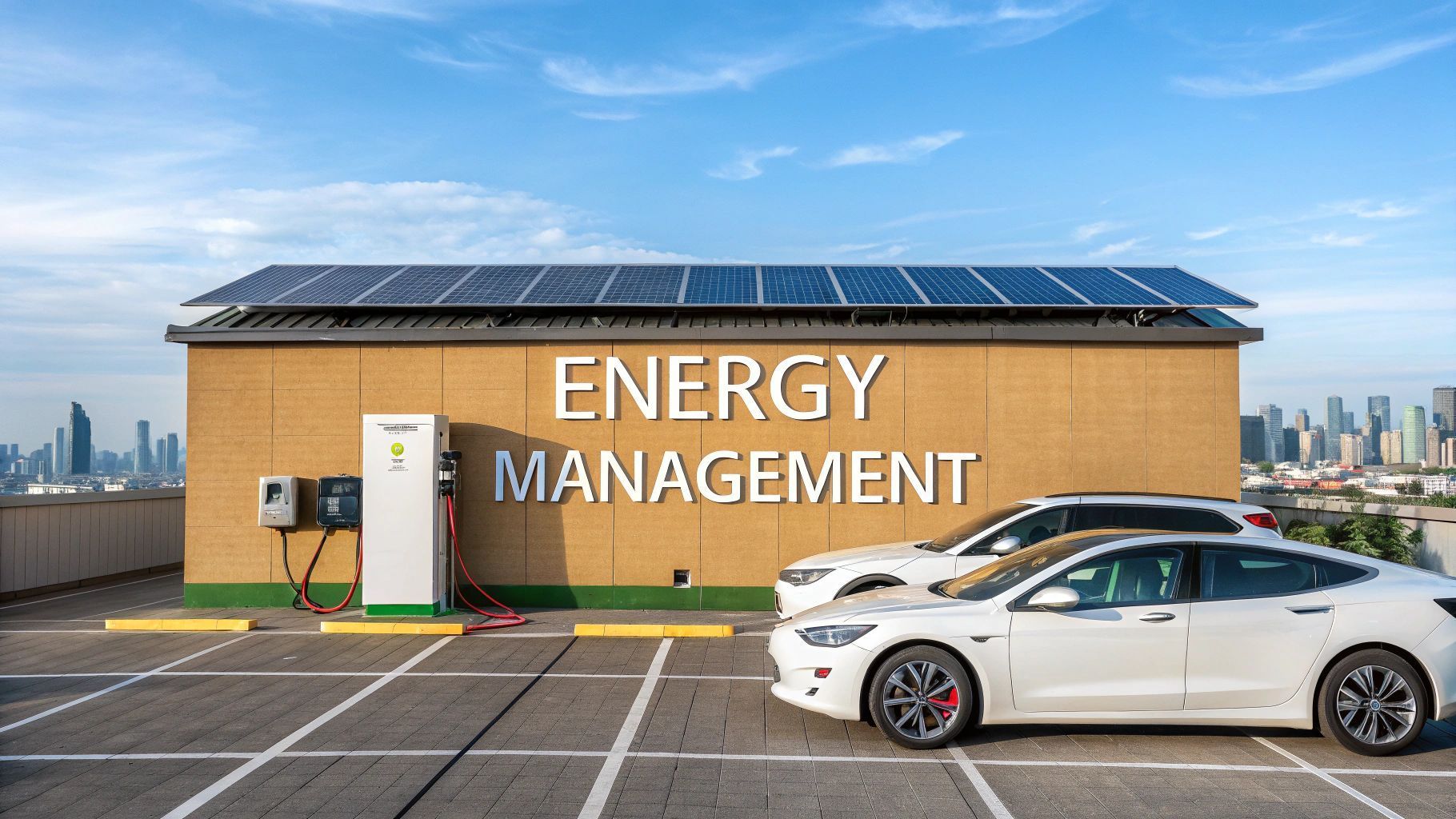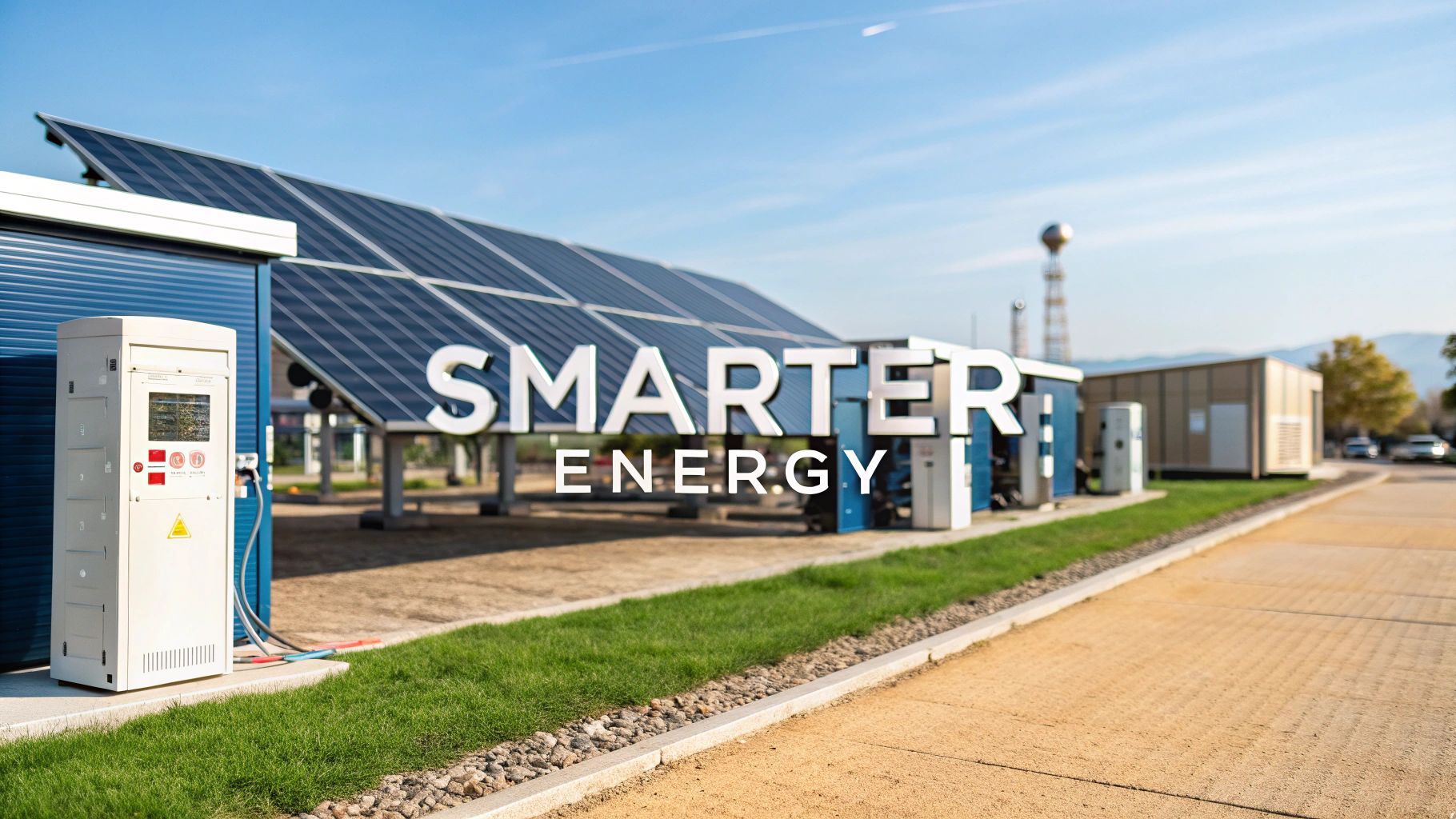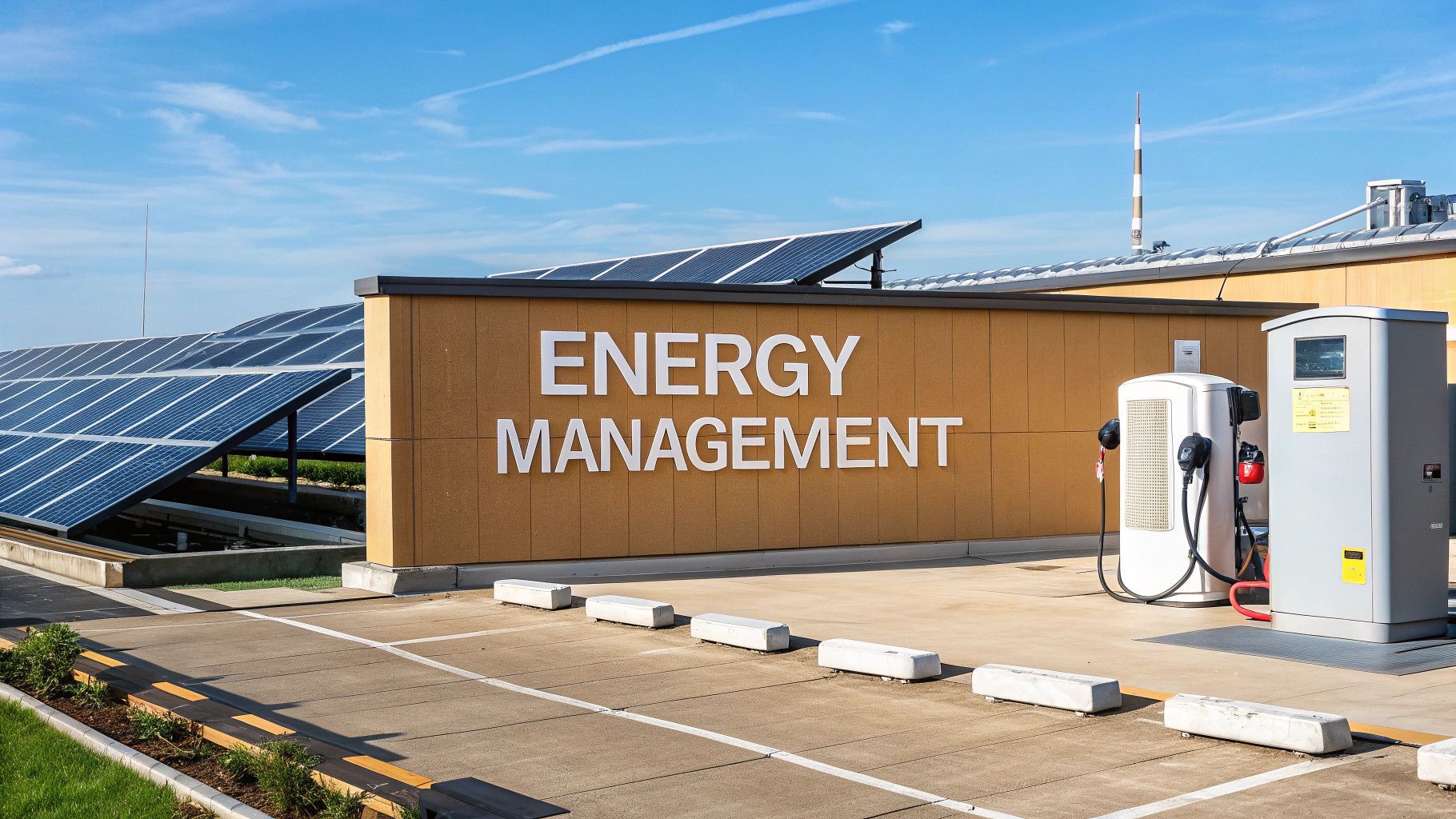A Guide to Electric Vehicle Supply Equipment
When you hear the term Electric Vehicle Supply Equipment , or EVSE , it's easy to think it's just a fancy name for the charger plug but it’s so much more than that. EVSE is the complete, intelligent system that safely moves electricity from the grid to your electric vehicle.
Think of it as the gatekeeper for your car's battery. It manages the entire power transfer, constantly communicates with your vehicle's onboard systems and ensures multiple layers of safety are always active. This equipment is absolutely fundamental to making the entire EV ecosystem work smoothly and safely.
Demystifying Electric Vehicle Supply Equipment
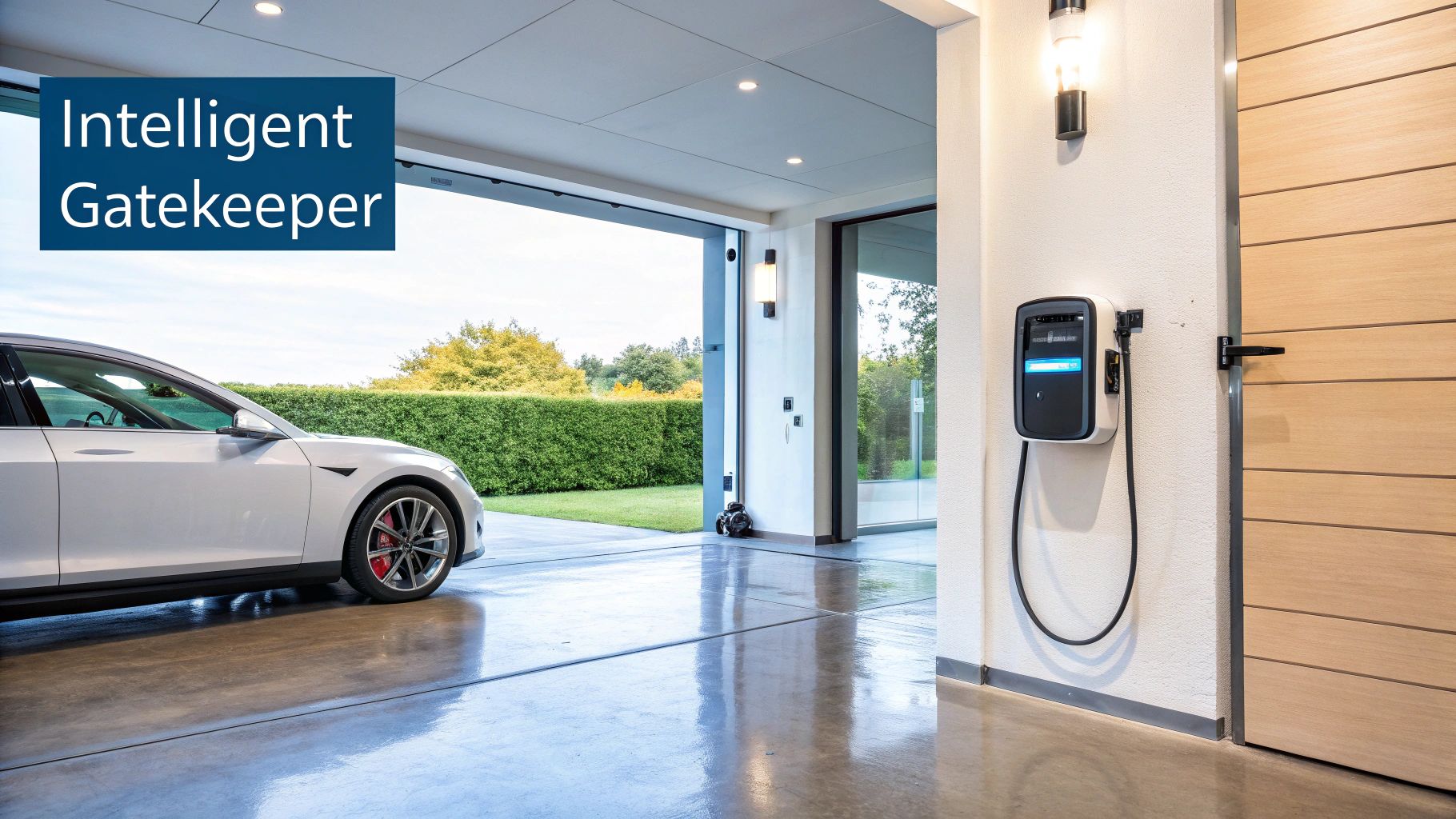
Here's a key distinction: the EVSE isn't technically the "charger." The actual component that converts AC power from the grid into DC power for the battery is already inside your car. The EVSE's real job is to make that process safe, efficient and reliable every single time you connect.
It’s a bit like an air traffic controller for electricity. It carefully guides the power from its source to its destination without any mishaps, all thanks to a constant digital "handshake" between the EVSE and the vehicle.
The Core Functions of EVSE
This constant communication is vital. Before any real power starts to flow, the EVSE confirms the vehicle is properly connected, scans for any faults in the system and figures out the maximum power the vehicle can safely accept. This careful dance prevents damage to the car's expensive battery and protects the local electricity supply from being overloaded.
To understand how EVSE works, it helps to break down its primary roles. The table below summarises the three critical jobs it performs every time you plug in.
EVSE Core Functions at a Glance
| Function | Description | Analogy |
|---|---|---|
| Power Delivery | Safely transfers electrical energy to the vehicle, managing the voltage and current according to the car's specific needs. | A smart water valve, adjusting the flow and pressure precisely to fill a container without spilling a drop. |
| Safety Interlocking | Incorporates crucial safety features like ground fault detection and automatic shutoffs to prevent electrical hazards during charging. | A circuit breaker in your home, instantly cutting power if it detects a dangerous fault to prevent shocks or fires. |
| Communication | Exchanges data with the EV to ensure an optimal and secure charging session, adjusting the power flow as required. | A continuous conversation between two computers, confirming every step is correct before proceeding. |
These functions work in tandem to create a seamless and secure charging experience, forming the backbone of reliable EV infrastructure.
More Than Just a Charging Point
When we talk about EVSE, it’s not just the charging unit itself. A proper installation includes the essential protective infrastructure around it. For instance, robust EV bollard systems are often installed to shield the station from accidental bumps and scrapes in busy car parks. This physical protection is a crucial part of a complete, durable setup that’s built to last.
EVSE is the foundational technology that makes convenient and widespread EV adoption possible. From a simple unit in a domestic garage to a high-powered hub on a motorway, it’s the unsung hero working behind the scenes.
As the EV market continues to grow, so does the demand for more advanced equipment. Businesses now have a huge range of options, from standard chargers to complex systems integrated with grid-scale batteries and combined on-site renewables. Understanding these systems is the first step in finding your ideal EV charger solution.
This guide will walk you through everything, from the basic components to the future of mobile EV charging and how to power vehicles even from constrained grid connections.
Understanding The Different Types Of EV Charging
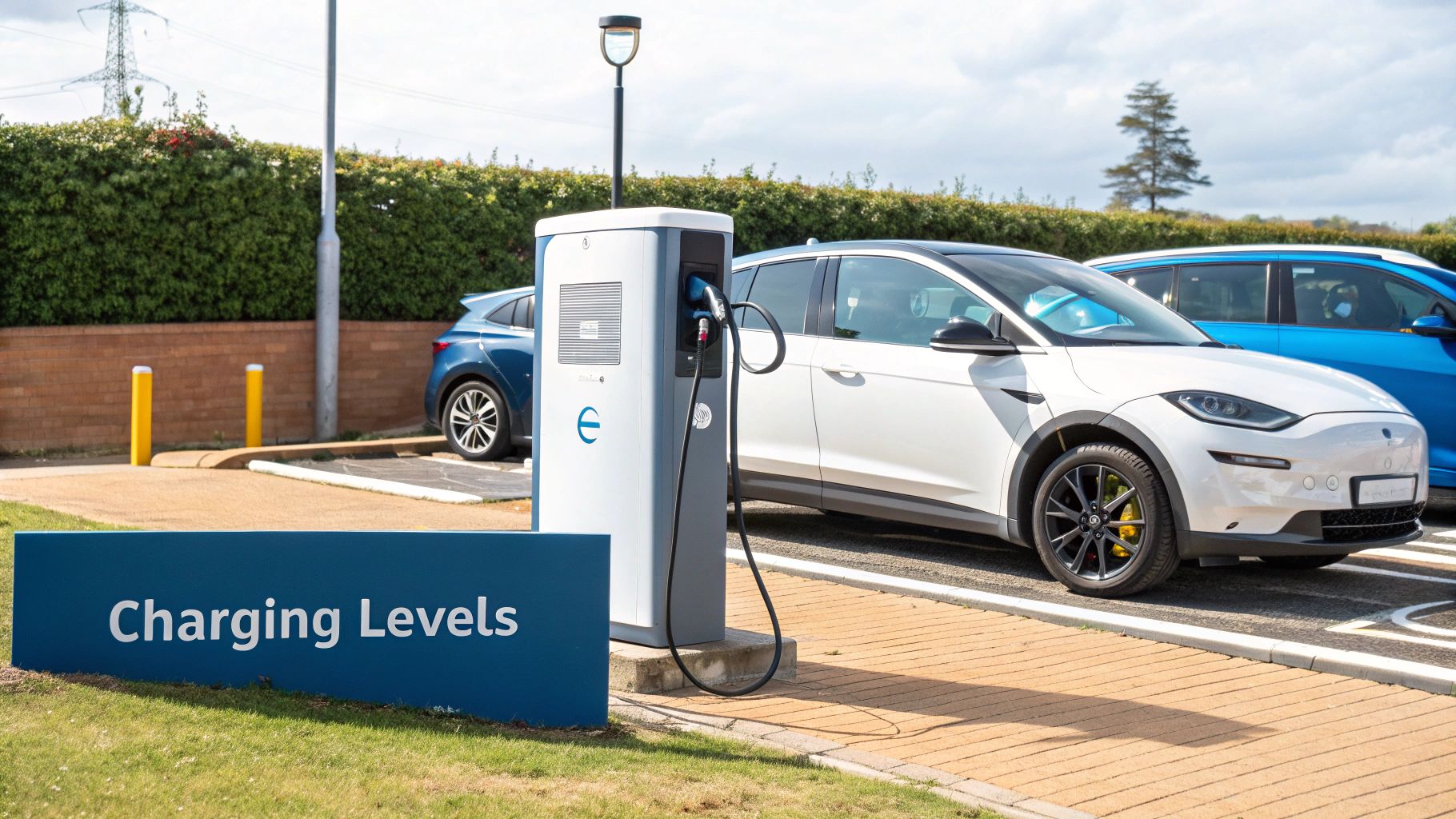
When it comes to EV charging, not all plugs are created equal. The world of electric vehicle supply equipment is split into different speeds and power levels, each designed for a specific situation. Getting to grips with these differences is the key to planning your day, your next long journey or even your business’s entire charging strategy.
It all boils down to the type of electrical current being used and how fast it can top up your car's battery.
Think of it like filling up a swimming pool. You could use a standard garden hose, which will get the job done eventually but it's going to take a very long time. Or, you could call in a high-pressure fire hose and fill it in a fraction of the time. EV charging works on a similar principle, with different "hoses" available for different needs.
We can split these into two main camps: AC (Alternating Current) and DC (Direct Current), which line up with different charging speeds and the places you'll typically find them.
Everyday AC Charging For Homes And Workplaces
Alternating Current (AC) charging is by far the most common type of EV charging you'll come across. This is the same power that comes out of your standard wall sockets, delivered by the national grid. There’s just one catch: a car's battery can only store Direct Current (DC) power.
This means that with an AC charger, the car has to do the hard work. Its own onboard converter has to change the electricity from AC to DC before it hits the battery. The size and capability of this internal converter put a cap on how fast the car can charge, usually somewhere between 3.6kW and 22kW .
- Home Charging: Most chargers installed at home run at about 7kW . This speed is perfect for overnight charging, as it can comfortably fill a typical EV battery in 6-12 hours . You just plug in when you get home and wake up to a full battery every morning.
- Workplace & Destination Charging: The chargers you see in office car parks, supermarkets or local gyms are often 7kW or 22kW units. They’re designed to give you a meaningful top-up while the car is parked for a few hours anyway.
AC charging might be slower but it's also gentler on the battery, which can help with its long-term health. It’s the backbone of the daily charging routine for most EV drivers.
Accelerating Journeys With Rapid DC Charging
Direct Current (DC) charging—often called rapid or ultra-rapid EV charging—completely changes the game. It bypasses the car's slow onboard converter entirely. Instead, the heavy lifting of converting AC grid power to DC happens inside the much bigger, more powerful charging station itself.
This allows power to be pumped directly into the battery at incredible speeds, starting at 50kW and going all the way up to 350kW or more. This is the technology that makes long-distance EV travel a breeze. You can learn more by reading your guide to fast charger electric vehicle technology.
Rapid DC charging is a game-changer for en-route charging. A 150kW ultra-rapid charger can add around 100 miles of range to a compatible EV in as little as 10-15 minutes , transforming motorway service stops.
The UK's charging network is clearly shifting towards this faster technology. As of May 2025, the UK had 16,259 rapid or ultra-rapid chargers, with an impressive 385 new units installed in that month alone. This rapid expansion, which includes over 650 hubs with six or more high-speed chargers, is making long journeys far more manageable for everyone.
Flexible Power With Mobile EV Charging
There's a third, increasingly vital category to consider: mobile EV charging. Think of these as powerful, portable battery packs on wheels. They are capable of delivering a fast DC charge wherever it’s needed, completely untethered from a fixed grid connection.
The flexibility this offers is immense. Fleet operators, for example, can use mobile units to charge vehicles at a depot without the cost and disruption of installing permanent infrastructure. They are also becoming essential for emergency roadside assistance, giving a stranded EV just enough juice to reach the nearest static charging station. On top of that, they can provide power at temporary events or on construction sites where permanent chargers simply aren't an option.
A Look Inside Your EV Charging Unit
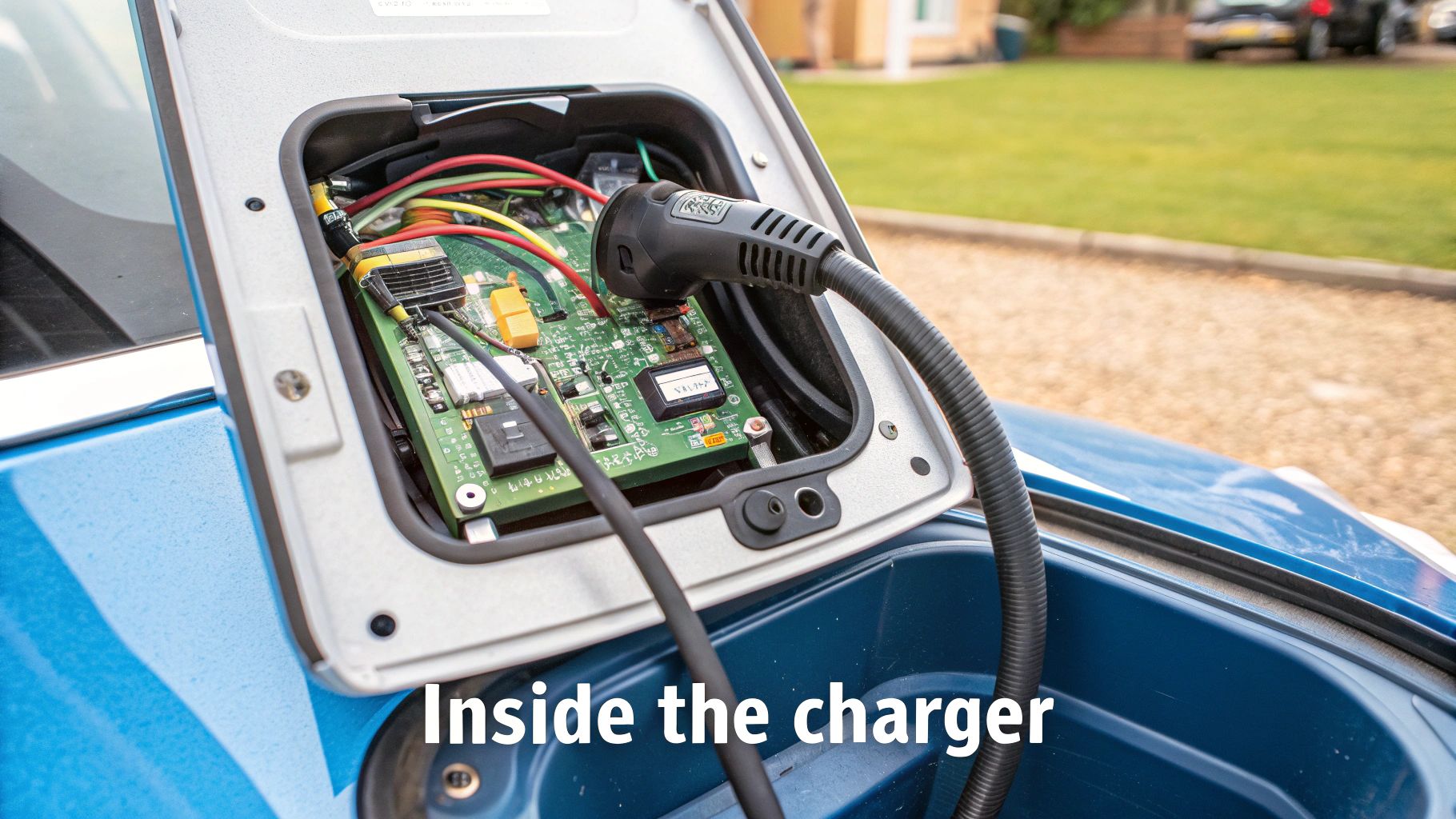
Ever wondered what’s really going on inside that box when you plug in your car? It’s a lot more than just a glorified power socket. Every piece of electric vehicle supply equipment is a sophisticated system, bringing together hardware, software and critical safety mechanisms to deliver a smooth, reliable charge.
If you were to lift the bonnet on a charging unit, you’d find several key components working in perfect harmony. Understanding these parts helps demystify how the equipment manages everything from high-power electricity flow to user interaction and—most importantly—keeping everyone safe. Let’s break down the core elements that make up a modern EV charging station.
Connectors and Cabling: The Physical Link
The first things you notice are, of course, the connector and its cable. Here in the UK and across Europe, you'll mainly come across two standards for public charging: the Type 2 connector for AC charging and the Combined Charging System (CCS) for the really fast DC stuff. The CCS plug is a clever bit of design, building on the Type 2 by adding two large DC pins below, making it a versatile all-in-one solution.
That chunky cable is just as important. It’s not your average wire; it’s a robust, heavily insulated conduit engineered to handle serious electrical loads for hours on end without breaking a sweat. The quality and thickness are non-negotiable for performance and safety, especially in high-powered rapid chargers where the currents are massive.
The Brain: The Internal Control Unit
At the very heart of the EVSE is its 'brain'—the internal control unit, or EVSE controller . Think of it as the central processor that manages the entire charging process from the moment you plug in. It’s responsible for that crucial "digital handshake" between your car and the charger.
This controller talks directly to your vehicle's battery management system to agree on the maximum charging rate the car can safely handle. It then continuously monitors the flow of electricity, checks for any faults and makes sure all safety protocols are active. This intelligent oversight prevents damage to your car's battery and stops the local grid connection from being overloaded. It's the unsung hero of every single charge.
A charger’s internal control unit is like an air traffic controller for electricity. It orchestrates a safe and orderly flow of power, constantly communicating with the vehicle to prevent any mishaps and ensure a smooth journey to a full battery.
Safety Systems: The Unseen Protectors
Perhaps the most critical components are the ones you never see. Built into every certified EVSE are multiple layers of protection designed to stop electrical faults in their tracks. A key device is the Residual Current Device (RCD) , which constantly watches the electrical current. If it detects even the tiniest imbalance—a sign of a dangerous current leak—it shuts off the power in milliseconds to prevent electric shock.
Another vital feature is earth fault detection . This system ensures that if there’s a fault, the electricity has a safe path to the ground, protecting both you and your vehicle. These unseen heroes work silently in the background, making EV charging one of the safest ways to refuel. Together, all these components form a dependable system that makes plugging in your car a simple, secure and routine activity.
Powering EVs From Constrained Grid Connections
One of the biggest hurdles to widespread EV adoption is the strain on our existing power grid. Many ideal spots for charging hubs, like remote service stations or older commercial sites, just don’t have the electrical muscle to support multiple rapid chargers. This section tackles that challenge head-on, exploring how we can deploy powerful EV charging equipment even where grid connections are limited.
It’s a common misconception that installing a bank of rapid EV chargers demands a massive—and often prohibitively expensive—grid upgrade. While that used to be the case, modern solutions now let us work around these limitations intelligently. The key is to stop seeing a charging station as a simple, passive drain on the grid and start seeing it as a dynamic part of a local energy ecosystem.
This approach combines smart technology with on-site energy resources, creating charging hubs that are more powerful, resilient and cost-effective than their grid connection would suggest. This is where combined on-site renewables and distributed energy become game-changers.
Smart Charging and Dynamic Load Balancing
The first layer of intelligence is smart charging . Instead of every charger pulling maximum power all at once and risking an overload, smart systems can manage the power distribution on the fly. This is known as dynamic load balancing .
Imagine a service station with a 100kW grid connection and five EV chargers. If five cars plug in at the same time, a basic setup would try to draw far more power than is available, tripping the circuit. Dynamic load balancing prevents this. It constantly monitors the total site load and cleverly distributes the available power across all active chargers.
This technology makes sure the site never exceeds its grid capacity but it also means charging speeds can slow down when the site is busy. While it’s effective, it’s only the first piece of the puzzle.
Creating Self-Sufficient Charging Hubs
The real breakthrough comes when we integrate distributed energy resources to build self-sufficient charging hubs. This means combining on-site power generation and storage to supplement a weak grid connection. By generating and storing your own electricity, you can deliver rapid EV charging far beyond what the grid alone could ever support.
The core components of this system are pretty straightforward:
- Grid-Scale Batteries: Large battery energy storage systems (BESS) are the heart of the solution. They can be slow-charged from the grid during off-peak hours when electricity is cheaper and demand is low. These EV charging batteries then stand ready to unleash stored energy at high power to vehicles during peak times.
- Combined On-site Renewables: Adding solar panels to canopies over parking bays or on nearby roofs provides a source of clean, low-cost power. This energy can charge vehicles directly on a sunny day or, more often, top up the on-site batteries for later use.
- Integrated Energy Management: A sophisticated control system manages this whole ecosystem. It balances power from the grid, solar generation and battery storage to meet real-time demand from the chargers. This ensures a seamless experience for drivers while minimising how much you rely on the grid.
This chart shows just how these integrated solutions boost efficiency and capacity, even on a constrained connection.
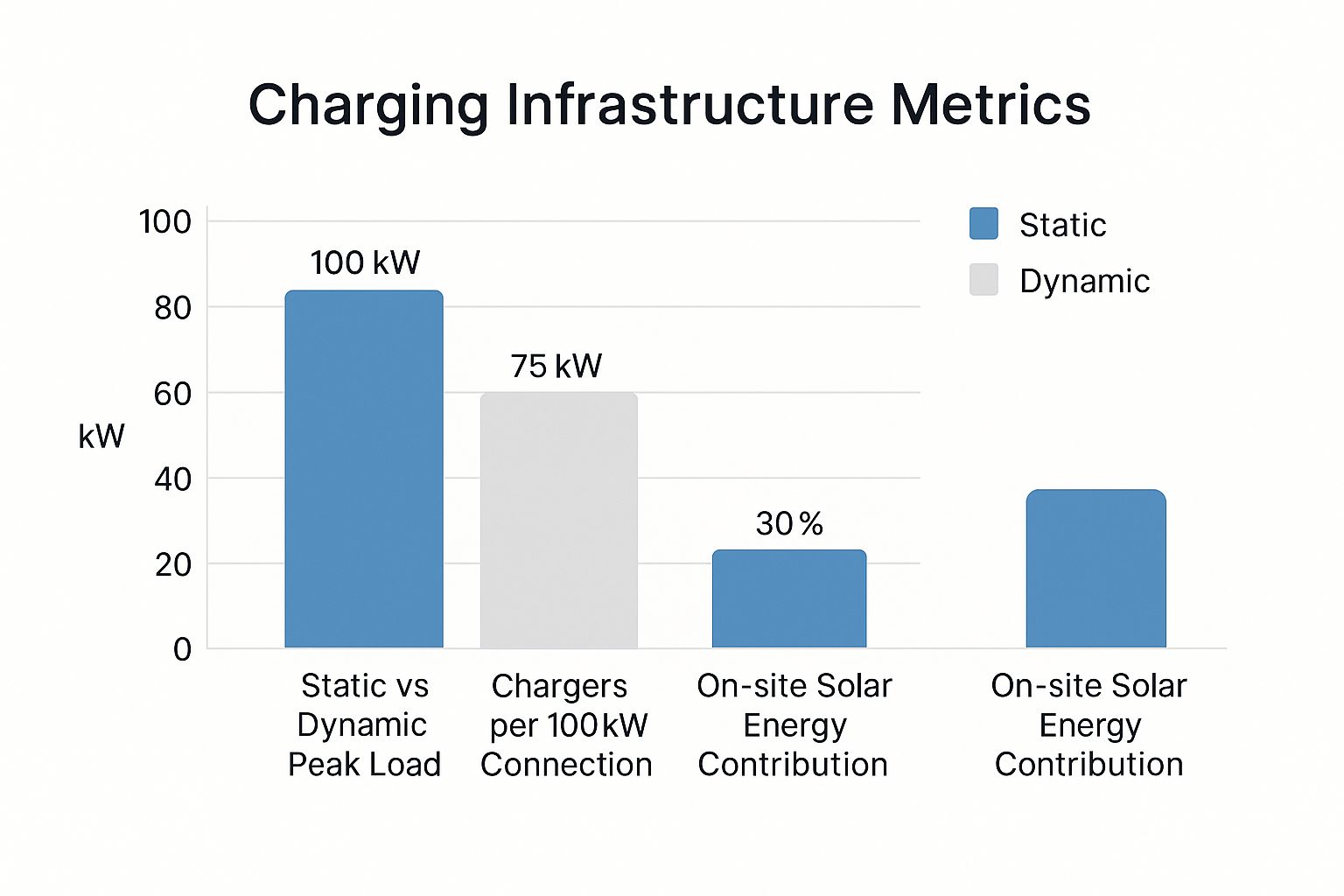
As you can see, with smart management and on-site resources, a site can slash its peak grid demand by 25% while supporting more chargers and using clean energy.
By combining grid-scale batteries with on-site renewables, a charging hub with a modest grid connection can operate like one with a multi-megawatt supply. It effectively creates its own microgrid, sidestepping the cost and delays of major utility upgrades.
This approach doesn’t just enable rapid charging in previously unsuitable locations; it also adds a crucial layer of resilience. If there’s a grid outage, the on-site battery can keep powering the chargers, ensuring business continues as usual. For any business looking to invest in future-proof infrastructure, understanding the power of battery-backed EV charging is essential. It turns a grid problem into a real energy opportunity.
Mapping The UK’s Growing EV Charging Network
To really get a handle on the UK's shift to electric vehicles, you have to look at the infrastructure holding it all up. The public charging network is expanding at a serious pace, laying the foundations for millions of drivers to make the switch. But this isn't just a numbers game; it's about putting the right chargers in the right places.
The big picture is one of rapid progress. Spurred on by government targets and massive consumer demand, new charging points are popping up every day. A lot of this effort is focused on the 'en-route' experience, with a clear mission to make long-distance EV travel as painless as pulling into a petrol station.
The National Charging Landscape
The UK's charging network has come a long way in a short time. As of July 2025, there were 82,002 public EV charging devices dotted across the country. That's a huge 27% jump from the previous year.
This rapid build-out shows a serious national commitment but the real story is in the type of chargers being installed. Of the total, 16,677 are rapid or ultra-rapid, making up 20% of all public devices. These are the game-changers, allowing drivers to add serious range in minutes, not hours. For a deeper dive, you can check out the government's official statistics on electric vehicle public charging infrastructure.
The strategy is clear: build a network that gives drivers the confidence to go electric without worrying about getting stranded.
Addressing Regional Disparities
However, the rollout hasn't been even. If you zoom in on the map, you’ll see a real postcode lottery starting to emerge. While major cities and transport corridors are increasingly well-catered for, many rural and remote areas are being left behind.
This imbalance is a major hurdle. It threatens to create a two-tier system, making EV ownership practical for some but impossible for others.
The goal of a truly national network is to ensure that no driver is left behind. Closing the gap between the best- and worst-served regions is the next great challenge for the UK's EV infrastructure rollout.
For example, Greater London is home to over a quarter of all the UK's public chargers, while other regions have just a tiny fraction of that. The gap is even more glaring when you look at it on a per-person basis, highlighting where investment needs to be targeted next.
The table below paints a clear picture of this contrast, breaking down the charger numbers and density across different UK regions.
Regional EV Charger Distribution in the UK
| Region | Total Devices | Devices per 100,000 Population |
|---|---|---|
| Greater London | 25,502 | 263 |
| South East | 9,850 | 105 |
| Scotland | 6,521 | 119 |
| Wales | 2,756 | 88 |
| Northern Ireland | 707 | 37 |
Data based on July 2025 figures, simplified for comparison.
As the numbers show, where you live massively impacts your access to public charging. While the overall growth is fantastic news, the real work now lies in building a truly comprehensive and equitable network that works for everyone, everywhere.
The Future of EV Charging Technology
The electric vehicle supply equipment we see today is just the beginning. The technology is evolving at an incredible pace, leading us towards a future where charging an EV is faster, smarter and more woven into our energy ecosystem than ever before. Tomorrow’s charging networks won’t just power cars—they’ll be active participants in the grid.
These advances aren't just about delivering power more efficiently. The real innovation lies in creating a seamless experience where the line between the vehicle, the charger and the wider energy network completely blurs. This means pushing the boundaries of charging speed while also introducing entirely new ways for vehicles to interact with the grid.
The Push Towards Ultra-Fast Charging
The race for speed is relentless. While today’s 150kW and 350kW chargers are already impressively quick, the industry is aiming much higher. The goal is to make a top-up stop virtually indistinguishable from a visit to a petrol station, adding hundreds of miles of range in just a handful of minutes.
This next generation of 400kW-plus charging will be a game-changer for high-mileage fleets and drivers on long journeys, wiping out any lingering concerns about distance. Getting there will demand more than just powerful chargers; it requires major steps forward in vehicle battery technology and cooling systems, too.
Bidirectional Charging and Vehicle-to-Grid
Perhaps the most profound shift on the horizon is the widespread adoption of bidirectional charging , often called Vehicle-to-Grid or V2G. This incredible technology turns every compatible EV into a mobile battery storage unit. Instead of only drawing power, the car can send stored energy back to the grid during peak demand.
Imagine a city where thousands of parked EVs help to stabilise the electricity supply, reducing the need for fossil-fuel power plants to fire up during peak evening hours. Drivers could even be paid for the energy they contribute, creating a new revenue stream from their car. This capability also extends to Vehicle-to-Home (V2H), where an EV could power a house during a blackout.
With Vehicle-to-Grid technology, the national fleet of electric vehicles becomes a vast, distributed energy resource. This transforms cars from passive energy consumers into active, grid-supporting assets, fundamentally changing our relationship with energy.
The Rise of Smart, Automated Systems
Future charging networks will be run by sophisticated software and artificial intelligence. This will create a far more reliable and user-friendly experience, with systems that can predict maintenance needs, manage energy flow in real-time and guide drivers to available chargers without a hitch.
We're also on the cusp of seeing wireless inductive charging become a reality. Imagine just parking over a designated spot and having your car charge automatically, with no plugs or cables needed. While still developing for high-power use, this technology holds enormous potential for public spaces, taxi ranks and home garages, making the whole process truly effortless.
This combination of speed, intelligence and integration points to a future where electric vehicle supply equipment is a cornerstone of a cleaner, more resilient energy system.
Common EVSE Questions Answered
Stepping into the world of electric vehicle charging can feel like learning a new language. For businesses looking to install their first chargers, a lot of practical questions naturally come up.
This section cuts through the jargon to give you clear, straightforward answers. Getting these fundamentals right is the key to making a smart investment in your site's future. Let's get into it.
How Do I Choose The Right EV Charger For My Site?
Choosing the right charger is less about the hardware itself and more about matching it to your location and the people who will use it. It's a balancing act between today's needs and tomorrow's growth.
First things first: power availability . Before you even think about charger models, you need a detailed electrical survey. This will tell you your site's maximum capacity, which is the single biggest factor dictating what's possible.
Next, think about who is charging and for how long . Are you serving employees who will be parked all day? Or are they customers who need a quick top-up and to be on their way? A staff car park is perfectly suited for 7kW AC chargers, while retail and hospitality sites can see huge benefits from installing 50kW+ DC rapid chargers.
Finally, think ahead. Your investment should be ready for what's coming. Opt for scalable systems that allow you to add more chargers as demand inevitably grows.
What Is The Difference Between AC And DC Charging?
The real difference between AC (Alternating Current) and DC (Direct Current) charging all comes down to one thing: where the power conversion happens. The national grid supplies AC power but your car's battery can only store DC power.
With an AC charger , the car's own small, onboard converter does all the work of changing AC to DC. This is why it's slower and ideal for situations where time isn't a factor, like overnight at home or during a full workday.
A DC rapid charger is a different beast entirely. It has a massive converter inside the charging unit itself , completely bypassing the car's smaller one. This allows it to feed DC power directly into the battery at a much higher speed, making it perfect for quick stops on long journeys.
Are All Public Chargers Compatible With My Car?
This used to be a major headache for early EV drivers but thankfully, things have become much simpler. In the UK, the industry has largely standardised on two main connectors.
Virtually all new electric cars here use the Type 2 plug for AC charging and the Combined Charging System (CCS) plug for DC rapid charging. The CCS plug is a clever piece of design that combines the standard Type 2 pins with two larger DC pins, creating a universal solution for most modern EVs.
While the plug type is rarely an issue now, the availability of chargers is another story. The infrastructure is spread unevenly across the country. For example, Greater London boasts over 25,502 public charging points, which is roughly 30% of the UK's entire network. In stark contrast, Northern Ireland has just 707 public devices. You can find more details in these UK EV charging statistics on uswitch.com.
For businesses, the key takeaway is that charger compatibility is largely solved. The real challenge—and opportunity—lies in choosing the right type and speed of electric vehicle supply equipment to meet the specific needs of your customers and location.
At ZPN Energy , we specialise in creating powerful, future-ready charging solutions that overcome grid limitations. From rapid charging hubs backed by on-site battery storage to scalable systems for your business, we deliver the infrastructure you need to succeed. https://www.zpnenergy.com


